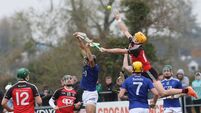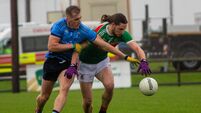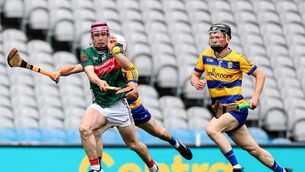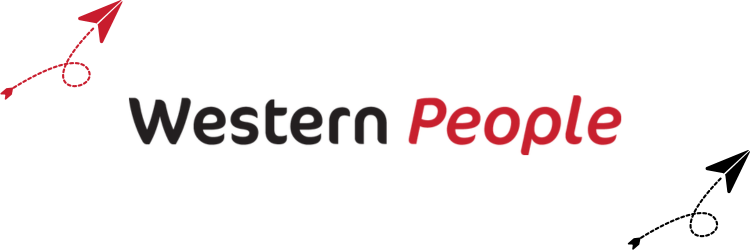Association is forgetting that clubs are its true heartbeat
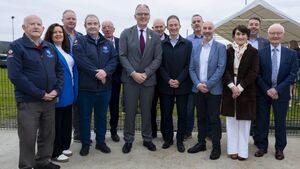
GAA President Jarlath Burns and Minister Alan Dillon TD with Kiltimagh GAA club officers at last Saturday morning's official opening of the club's redeveloped Joseph Gilmartin Memorial Park. It was a case of double the delight for Kiltimagh as later in the day they booked their ticket to the Mayo Junior Football Championship Final with a semi-final victory over Ardagh in Foxford. Picture: John Corless
What a difference a week makes. Or two.
Saturday, September 28 just gone was a day from heaven as Eachléim’s Éigse flowed. A week later the county, the GAA calendar at least, was washed out and cancelled (correct decision by the way) by Storm Amy. With lorries blown off the road at Corrick and storms lashing the coast, chasing the bladder and case around the pitch would have been foolhardy at a minimum. So Crossmolina and Westport, a tasty morsel, and then the rest of the weekend’s fare was scratched. A pity but necessary.
Fast forward another week and the weather played ball again. And so did the players.
But the sequence of events had set me thinking. Old age does that to you; you have more to see in the rearview mirror than on the road ahead.
My Facebook timeline and Instagram feed had kept throwing up pictures of All-Irelands past: Galway v Meath 1966, Dublin v Galway 1974, Mayo v Meath 1996, Dublin v Mayo 2016 etc. Puzzled at first as to why, the penny finally dropped – the month of September was All-Ireland month, specifically the third Sunday. Our lives were shaped around it, a holiday home for our emigrants, a weekend in Dublin for us country folk, the autumn crowned and food for the winter stocked. My online timelines were recalling a past that’s rapidly changing.
And then, whizz and bang, it was gone; just like the Railway Cup with its 40,000 gates up to the middle of the last century before it was deemed twee. Luckily they replaced the provincial St Patrick’s Day fixture with the jewel (allegedly) in the GAA crown, the club. Despite being in place since the early 1970s, the club final only came to Croke Park in the early 1990s. With the pressure on players and fixtures, the club season was truncated into, ahem, supposedly the end of each county’s championship exit. The club finals are now played in January. Which poses and answers the question as to whom supremacy rests with in the GAA. The club or the county?
Mayo exited the intercounty scene mid-June, four months ago. So why at the weekend were we still only at the semi-final stage in the club championship? The county’s first league match was against the Dubs on January 25, a total of eight matches in that competition including the final was quickly consigned and then it was onto three provincial championship matches leading into a four team round robin set up from which three teams emerged. We weren’t one of them. The thinking then is that the club scene emerges from meaningless league matches and anonymity and basks in the sun for what’s left of the summer. But no. Either tacitly or with a nod, some players head stateside for a month or so, thus parking the start of the various club championships.
Now let’s be clear here. I’m not advocating a player cannot go on holiday. No, I actually encourage ALL players to have a summer holiday. But because the GAA have now placed the county team as the centre of its crown, allowing the clubs to emerge after the intercounty championship has been completed, club players now must juggle football commitments with holiday arrangements plus summer social events like weddings, stags and other community commitments. The county man looks west to America to stretch the legs and the club scene is parked until August in many counties. Also, the county man is then expected to don the club jersey, quite often it being twelve months since he last donned it. And. If you are number 21 to whatever…36 on the Mayo panel, you might have played little actual combative football in that time for either.
On the other hand, if you are a Jordan Flynn or another successful club and county player, you are now heading into season two of non-stop playing for club and county. Crossmolina started the 2024 season as an intermediate team. That took them into last January, a month which saw Flynn return to the county fold. It’s now October and only now will Flynn have a short break. Conceivably, the Deel Rovers could have gone until January 2026. Ballina Stephenites and Westport might, so other lads might not be far behind Flynn for wear and tear. Despite the GAA suggestions that the spilt season works, it’s my opinion it doesn’t. It works in the sense that the county team is given a free run from November of one year until whenever the championship ends, be that June or July the following year.
But. Is the GAA now county centric? Stupid question really. It is. Seven league matches from which, us being amongst the worst culprits, the moaning starts because reaching the final leaves you too near the start of the championship depending on which province you hail from. We then are melodeoned into a provincial championship that’s of an unequal set up. Ulster is a battlefield, Munster has gerrymandered it again that Cork and Kerry reach that final, thus ensuring two seeds for the group stages. Leinster, after Dublin’s lengthy dominance, has been weakened almost beyond repair with a single team now operating in Division One from the province. And if we avoid Galway or occasionally Roscommon, we too make the round robin cut.
So why is it all about the county? True, the profile is high but as far back as the days of Mayo 1936 the profile was high. And of course life moves on, change was needed, but as in our case to cite one example, playing six ‘championship’ matches and yet failing to reach a knockout stage is a tad over the top. This is not just us. Too many meaningless and forgotten games until we actually come down to a preliminary quarter-final or quarter-final proper. Then the ‘real’ championship catches fire. As an exercise, list off the eight actual quarter-finalists this season. I cannot. But I’ll list every semi-final from 1960 until about six years ago for you. We are overloaded without needing to be overloaded. It’s the follower who pays the price, along with the club.
The template for this has been already patented. The professionalisation of Irish rugby early 1990s saw the primacy of St Mary’s, Garryowen, Young Munster, Instonians, Malone, Galwegians and others reduced to feeder clubs; indeed in Leinster it appears as though it’s the colleges that provide that conduit into the Leinster setup and not the clubs. Hence we now have four provinces, one well resourced, two moderately resourced and one that has to budget tightly.
Rugby’s advantage is that it has an international audience and attraction – the GAA hasn’t and theoretically should depend on the club and the volunteers that underpin it. However, in the efforts to promote county over club, also embracing both the ladies and camogie intercounty entities under the Croke Park umbrella, the cost has been to the clubs.
Revenue will now come from TV and radio deals, commercial opportunities constantly sought and Croke Park, which is now the Swiss knife of corporate and entertainment and sporting promotion. We have had American football there, soccer, rock concerts, annual conferences, courts, tourist attractions and tours. Has the GAA gotten beyond its original aims and too large to be fed? In trying to unite the three entities into one, in trying to ensure that the county entity in each case gets primacy, does the local club suffer? And who or what is the club?
Part of it, indeed its main lifeblood, are the people that support it, that mark the pitch, wash the jerseys, sell the lotto tickets, manage the teams from under 6 upwards, pay at the gate or man that gate, providing security and safety etc. Businesses and people who dip into their pockets time and time again for that unique sense of community that makes Gaelic football the badge of the Gael.
If the follower, the volunteer, the sandwich maker, the jersey washer, the Horse who marks the pitch and cuts its grass, Patricia who ensures that all bills are paid and Garda clearance has been obtained for all… if all those find that their endeavours are essentially funnelled so as headquarters and the GPA and elite managerial elite can rest easy in clover, then Croke Park may have to ensure more American football matches take place on its hallowed grounds. They simply will stop volunteering.
The GAA’s greatest test will be to marry who gets paid and who doesn’t. Balancing that won’t be easy. Both headquarters and the GPA seem happy to rattle the tin as often as they can – but who fills it?
In a way, the weekends gone by are a reminder to me that nothing should be taken for granted. Not the weather, nor our wonderful players, clubs and volunteers and supporters, nor the excellent work done by TG4 and local media bringing the fare to the eyes and ears of those who cannot be physically present.
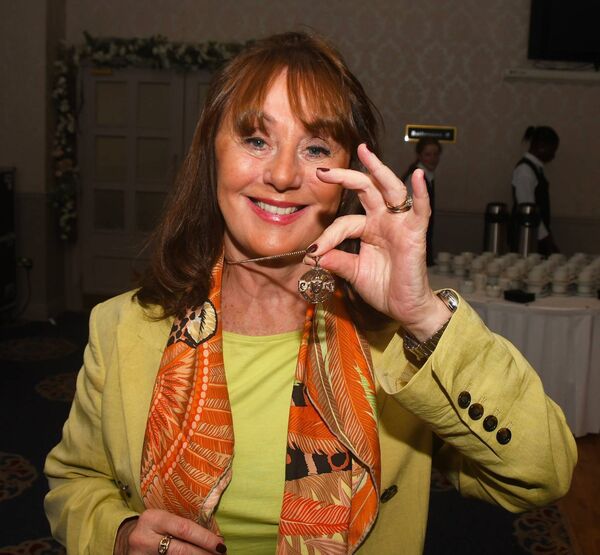
Currently I’m hearing too much about what county players aren’t getting and nothing about the massive opportunity they do get. Most boys and girls would give an eye tooth for that chance. Croke Park is worried about aligning to EU competition law so as we won’t upset outside business wishing to enter the lucrative sporting market, yet is silent when many counties have demanded that the GAA break its sponsorship with a bank connected to issues in the Middle East.
The GAA grew from what the people wanted. Irish people adopted it into its blood. It’s sporting, cultural and language connections tie us all. It was never envisaged that it become a behemoth for vested entities or business opportunities. Part of me sees the GAA outgrowing its identity and past. Time to get back to basics perhaps.
After the disappointment of the postponements, last weekend allowed us to appreciate what this great game grew from in the first instance – the club. A far more equitable entity than any county.
